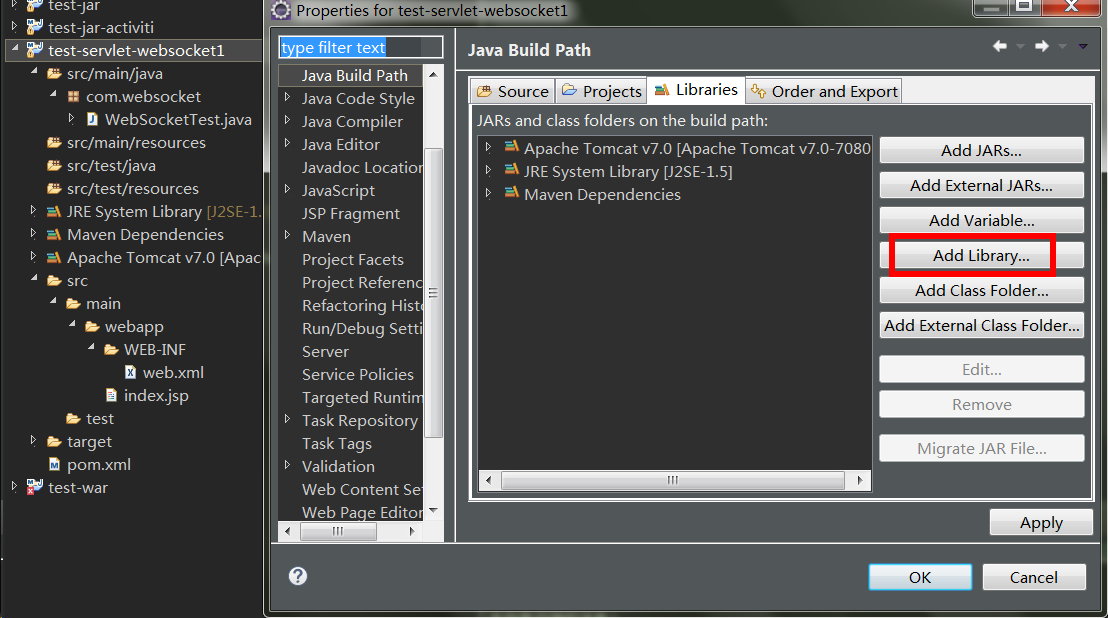websoclet简单示例 my 改
首先,创建一个 maven war 项目:

首先,pom文件:
<project xmlns="http://maven.apache.org/POM/4.0.0" xmlns:xsi="http://www.w3.org/2001/XMLSchema-instance" xsi:schemaLocation="http://maven.apache.org/POM/4.0.0 http://maven.apache.org/xsd/maven-4.0.0.xsd"> <modelVersion>4.0.0</modelVersion> <groupId>com.my</groupId> <artifactId>test-servlet-websocket1</artifactId> <version>0.0.1-SNAPSHOT</version> <packaging>war</packaging> <dependencies> <dependency> <groupId>javax</groupId> <artifactId>javaee-api</artifactId> <version>7.0</version> <scope>provided</scope> </dependency> </dependencies> </project>
然后,java代码只有一个类:
package com.websocket; import java.io.IOException; import java.util.concurrent.CopyOnWriteArraySet; import javax.websocket.OnClose; import javax.websocket.OnError; import javax.websocket.OnMessage; import javax.websocket.OnOpen; import javax.websocket.Session; import javax.websocket.server.ServerEndpoint; /** * @ServerEndpoint 注解是一个类层次的注解,它的功能主要是将目前的类定义成一个websocket服务器端, * 注解的值将被用于监听用户连接的终端访问URL地址,客户端可以通过这个URL来连接到WebSocket服务器端 */ @ServerEndpoint("/websocket") public class WebSocketTest { //静态变量,用来记录当前在线连接数。应该把它设计成线程安全的。 private static int onlineCount = 0; //concurrent包的线程安全Set,用来存放每个客户端对应的MyWebSocket对象。若要实现服务端与单一客户端通信的话,可以使用Map来存放,其中Key可以为用户标识 private static CopyOnWriteArraySet<WebSocketTest> webSocketSet = new CopyOnWriteArraySet<WebSocketTest>(); //与某个客户端的连接会话,需要通过它来给客户端发送数据 private Session session; /** * 连接建立成功调用的方法 * @param session 可选的参数。session为与某个客户端的连接会话,需要通过它来给客户端发送数据 */ @OnOpen public void onOpen(Session session){ this.session = session; webSocketSet.add(this); //加入set中 addOnlineCount(); //在线数加1 System.out.println("有新连接加入!当前在线人数为" + getOnlineCount()); } /** * 连接关闭调用的方法 */ @OnClose public void onClose(){ webSocketSet.remove(this); //从set中删除 subOnlineCount(); //在线数减1 System.out.println("有一连接关闭!当前在线人数为" + getOnlineCount()); } /** * 收到客户端消息后调用的方法 * @param message 客户端发送过来的消息 * @param session 可选的参数 */ @OnMessage public void onMessage(String message, Session session) { System.out.println("来自客户端的消息:" + message); //群发消息 for(WebSocketTest item: webSocketSet){ try { item.sendMessage(message); } catch (IOException e) { e.printStackTrace(); continue; } } } /** * 发生错误时调用 * @param session * @param error */ @OnError public void onError(Session session, Throwable error){ System.out.println("发生错误"); error.printStackTrace(); } /** * 这个方法与上面几个方法不一样。没有用注解,是根据自己需要添加的方法。 * @param message * @throws IOException */ public void sendMessage(String message) throws IOException{ this.session.getBasicRemote().sendText(message); //this.session.getAsyncRemote().sendText(message); } public static synchronized int getOnlineCount() { return onlineCount; } public static synchronized void addOnlineCount() { WebSocketTest.onlineCount++; } public static synchronized void subOnlineCount() { WebSocketTest.onlineCount--; } }
引入这个类后,第一个注解 @serverEndpoint 就会报错,因为缺少 websocket的jar包,这个jar包不用下载,在tomcat中就有(tomcat7以上版本),可以直接在项目上右键,添加tomcat运行环境:


一路确认即可。
这时,java类就不报错了。
然后项目下只要有一个默认的 web.xml即可,不用做任何修改:
<?xml version="1.0" encoding="UTF-8"?> <web-app xmlns:xsi="http://www.w3.org/2001/XMLSchema-instance" xmlns="http://java.sun.com/xml/ns/javaee" xsi:schemaLocation="http://java.sun.com/xml/ns/javaee http://java.sun.com/xml/ns/javaee/web-app_2_5.xsd" version="2.5"> <welcome-file-list> <welcome-file>index.html</welcome-file> <welcome-file>index.htm</welcome-file> <welcome-file>index.jsp</welcome-file> <welcome-file>default.html</welcome-file> <welcome-file>default.html</welcome-file> <welcome-file>default.jsp</welcome-file> </welcome-file-list> </web-app>
然后是前台jsp,在 webapp下放一个index.jsp:
<%@ page language="java" pageEncoding="UTF-8" %> <!DOCTYPE html> <html> <head> <title>Java后端WebSocket的Tomcat实现</title> </head> <body> Welcome<br/><input id="text" type="text"/> <button onclick="send()">发送消息</button> <hr/> <button onclick="closeWebSocket()">关闭WebSocket连接</button> <hr/> <div id="message"></div> </body> <script type="text/javascript"> var websocket = null; //判断当前浏览器是否支持WebSocket if ('WebSocket' in window) { //最后的 "websocket" 与 WebSocketTest 类中 @ServerEndpoint("/websocket") 注解中的值一致 // websocket = new WebSocket("ws://localhost:7080/项目名/websocket"); websocket = new WebSocket("ws://localhost:7080/test-servlet-websocket1/websocket"); } else { alert('当前浏览器 Not support websocket') } //连接发生错误的回调方法 websocket.onerror = function () { setMessageInnerHTML("WebSocket连接发生错误"); }; //连接成功建立的回调方法 websocket.onopen = function () { setMessageInnerHTML("WebSocket连接成功"); } //接收到消息的回调方法 websocket.onmessage = function (event) { setMessageInnerHTML(event.data); } //连接关闭的回调方法 websocket.onclose = function () { setMessageInnerHTML("WebSocket连接关闭"); } //监听窗口关闭事件,当窗口关闭时,主动去关闭websocket连接,防止连接还没断开就关闭窗口,server端会抛异常。 window.onbeforeunload = function () { closeWebSocket(); } //将消息显示在网页上 function setMessageInnerHTML(innerHTML) { document.getElementById('message').innerHTML += innerHTML + '<br/>'; } //关闭WebSocket连接 function closeWebSocket() { websocket.close(); } //发送消息 function send() { var message = document.getElementById('text').value; websocket.send(message); } </script> </html>
这里面,最最需要注意的就是这个路径:
//最后的 "websocket" 与 WebSocketTest 类中 @ServerEndpoint("/websocket") 注解中的值一致
// websocket = new WebSocket("ws://localhost:7080/项目名/websocket");
websocket = new WebSocket("ws://localhost:7080/test-servlet-websocket1/websocket");
ws:后面就是 ip 地址 : 端口号 / 当前项目名称 / WebSocketTest 类上 @ServerEndpoint("/websocket") 注解中的字符串
然后就可以测试了,效果如下:
同时打开Google浏览器和火狐浏览器进行多客户端模拟测试,运行效果如下:

参考原文:
https://www.cnblogs.com/xdp-gacl/p/5193279.html



